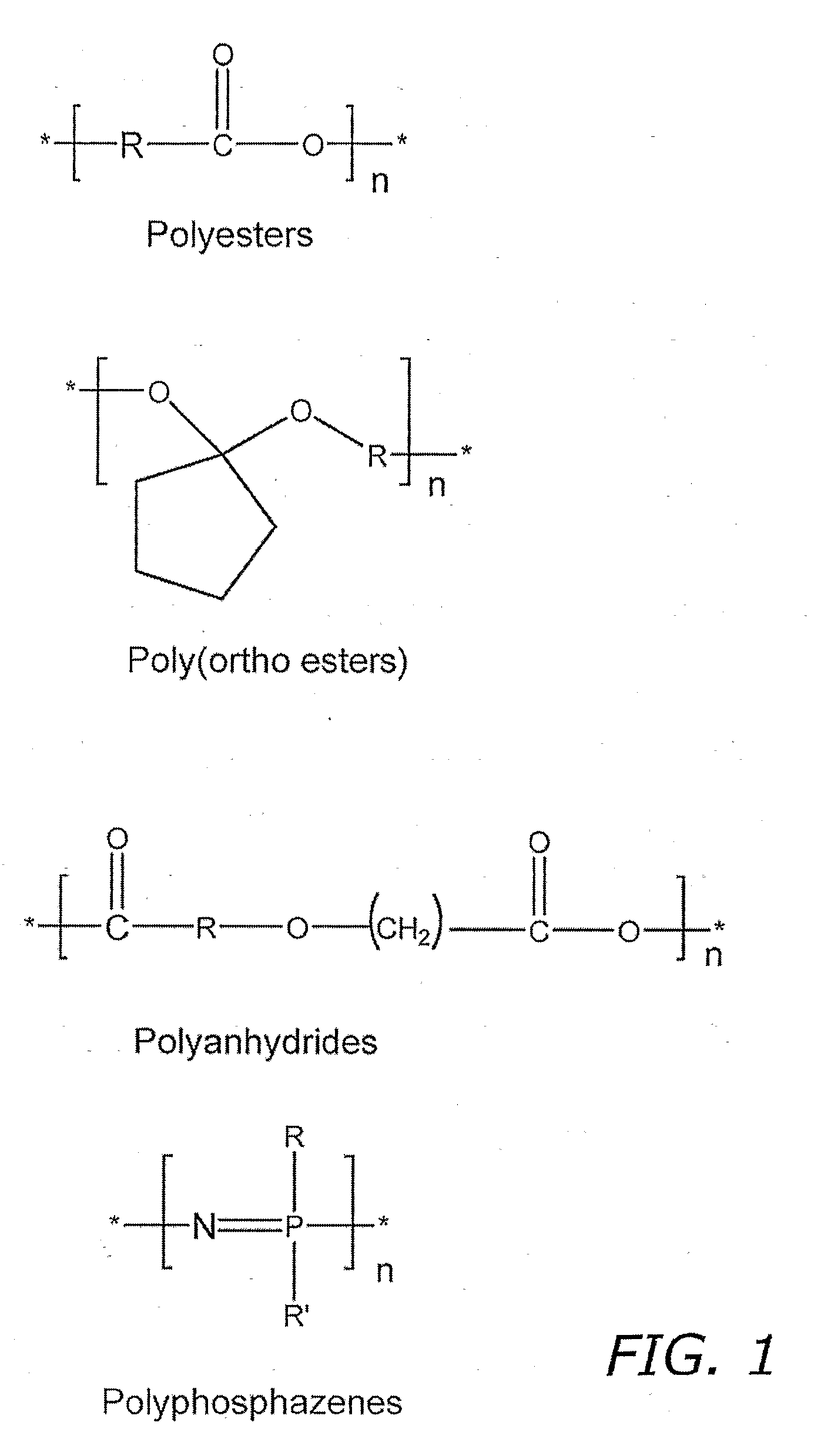Nitric Oxide-Releasing Biodegradable Polymers Useful as Medical Devices and Coatings Therefore
a biodegradable polymer and nitric oxide technology, applied in the field of medical devices having coatings, can solve the problems of irreparable damage, persistent risk of thrombogenesis and restenosis, and injury of the vessel wall at the site of balloon expansion or stent deployment, so as to prevent or inhibit thrombogenesis and restenosis. , the effect of treating and inhibiting
- Summary
- Abstract
- Description
- Claims
- Application Information
AI Technical Summary
Benefits of technology
Problems solved by technology
Method used
Image
Examples
example 1
Synthesis of Biodegradable Polymer of Formula II
[0067]
[0068]The ratio of a:b:c:d is a=40-45, b=10-12, c=0.1-0.5 and d=40-45.
[0069]In one embodiment of the present invention, the polymer of Formula II can be synthesized as follows: 0.5 gram of PEG-3400, 5 gram of D,L-lactide (3,6-dimethyl-1,4-dioxane-2,5-dione), 5 gram of L-lactide ((3s)-cis-3,6-dimethyl-1,4-dioxane-2,5-dione), approximately 1 gram of [1,4]oxazepan-7-one and 0.12 gram of Tin (II) 2-ethyl hexanoate are added into a 100 mL glass serum bottle. A Teflon-coated magnetic stir bar is added into the bottle and the bottle was sealed with Teflon-coated silicon septum with crimper. The reaction bottle is purged with nitrogen for 20 minutes and then placed in a 140° C. silicon oil bath with a stir bar in it for 72 hours. The reactant is dissolved in 20 mL chloroform and poured into about 200 mL of methanol for precipitation. This procedure is repeated three times. The final purified polymer is dissolved in chloroform and poured ...
example 2
Synthesis of Biodegradable Polymer of Formula III
[0071]
[0072]The ratio of a:b:c is a=90-99, b=0.1-1 and c=0.5-2.0.
[0073]In one embodiment of the present invention, the polymer of Formula ill may be synthesized as follows: 0.5 gram of PEG-3400, 9 gram of D,L-lactide (3,6-dimethyl-1,4-dioxane-2,5-dione), approximately 0.5 gram of [1,4]oxazepan-7-one and 0.10 gram of Tin (II) 2-ethyl hexanoate are added into a 100 mL glass serum bottle. A Teflon-coated magnetic stir bar is added into the bottle and the bottle was Sealed with a Teflon-coated silicon septum with crimpier. The reaction bottle is purged with nitrogen for 20 minutes and then placed in a 140° C. silicon oil bath with a stir bar in it for 72 hours. The reactant is dissolved in 20 mL chloroform and poured into about 200 mL of methanol for precipitation. This procedure was repeated three times. The final purified polymer is dissolved in chloroform and poured into a PTFE tray. The tray is placed in a vacuum oven at 50° C. overni...
example 3
Synthesis of Biodegradable Polymer Having the Formula Iv
[0075]
[0076]The ratio of a:b:c is a=1-5, b=90-99 and c=0.1 to 1.0.
[0077]In one embodiment of the present invention, the polymer of Formula IV may be synthesized as follows: 9 gram of D,L-lactide (3,6-dimethyl-1,4-dioxane-2,5-dione), approximately 0.5 gram of [1,4]oxazepan-7-one, 0.5 gram of ε-caprolactone and 0.10 gram of Tin (II) 2-ethyl hexanoate are add into a 100 mL glass serum bottle. A Teflon-coated magnetic stir bar is added into the bottle and the bottle was sealed with Teflon-coated silicon septum with crimpier. The reaction bottle is purged with nitrogen for 20 minutes and the placed in a 140° C. silicon oil bath with a stir bar in it for 72 hours. The reactant is dissolved in 20 mL chloroform and poured into about 200 mL of methanol for precipitation. This procedure is repeated three times. The final purified polymer is dissolved in chloroform and poured into a PTFE tray. The tray is placed in a vacuum oven at 50° C....
PUM
| Property | Measurement | Unit |
|---|---|---|
| thick | aaaaa | aaaaa |
| thick | aaaaa | aaaaa |
| diameter | aaaaa | aaaaa |
Abstract
Description
Claims
Application Information
 Login to View More
Login to View More - R&D
- Intellectual Property
- Life Sciences
- Materials
- Tech Scout
- Unparalleled Data Quality
- Higher Quality Content
- 60% Fewer Hallucinations
Browse by: Latest US Patents, China's latest patents, Technical Efficacy Thesaurus, Application Domain, Technology Topic, Popular Technical Reports.
© 2025 PatSnap. All rights reserved.Legal|Privacy policy|Modern Slavery Act Transparency Statement|Sitemap|About US| Contact US: help@patsnap.com



